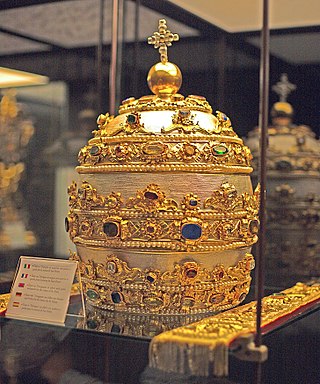
The Holy See, also called the See of Rome, Petrine See or Apostolic See, is the central governing body of the Catholic Church and the Vatican City State. It encompasses the office of the pope as the bishop of the Apostolic episcopal see of Rome and serves as the spiritual and administrative authority of the worldwide Catholic Church and the city-state. Under international law, the Holy See holds the status of a sovereign juridical entity.

The pope is the bishop of Rome and the visible head of the worldwide Catholic Church. He is also known as the supreme pontiff, Roman pontiff or sovereign pontiff. From the eighth century until 1870, the pope was the sovereign or head of state of the Papal States, and since 1929, of the much smaller Vatican City State. The current pope is Francis, who was elected on 13 March 2013.

The national flag of Vatican City was adopted in 1929, the year Pope Pius XI signed the Lateran Treaty with Italy, creating the new independent state of Vatican City.

The papal tiara is a crown that is worn by popes of the Catholic Church from as early as the 8th century to the mid–20th century. It was last used by Pope Paul VI in 1963, and only at the beginning of his reign.

The Camerlengo of the Holy Roman Church is an office of the papal household that administers the property and revenues of the Holy See. Formerly, his responsibilities included the fiscal administration of the Patrimony of Saint Peter. As regulated in the apostolic constitution Pastor bonus of 1988, the Camerlengo is always a cardinal, though this was not the case prior to the 15th century. His heraldic arms are ornamented with two keys – one gold, one silver – in saltire, surmounted by an ombrellino, a canopy or umbrella of alternating red and yellow stripes. These also form part of the coat of arms of the Holy See during a papal interregnum. The Camerlengo has been Kevin Farrell since his appointment by Pope Francis on 14 February 2019. The Vice Camerlengo has been Archbishop Ilson de Jesus Montanari since 1 May 2020.

The mitre or miter is a type of headgear now known as the traditional, ceremonial headdress of bishops and certain abbots in traditional Christianity. Mitres are worn in the Catholic Church, Eastern Orthodox Church, Oriental Orthodox Churches, the Anglican Communion, some Lutheran churches, for important ceremonies, by the Metropolitan of the Malankara Mar Thoma Syrian Church, and also, in the Catholic Church, all cardinals, whether or not bishops, and some Eastern Orthodox archpriests.

Sede vacante refers, in the Canon Law of the Catholic Church, to the state during which a diocese or archdiocese is without a prelate installed in office, with the prelate's office being the cathedral. The term is used frequently in reference to papal vacancies occurring upon the Pope's death or resignation.

Vatican euro coins are issued by the Philatelic and Numismatic Office of the Vatican City State and minted by Istituto Poligrafico e Zecca dello Stato (IPZS), in Rome, Italy. The euro is the official currency of the Vatican City, although Vatican City is not a member of the Eurozone or the European Union. The euro has been the official currency of Vatican City since 2002. Before that, the Vatican lira was the official currency.

Papal regalia and insignia are the official items of attire and decoration proper to the Pope in his capacity as the visible head of the Catholic Church and sovereign of the Vatican City State.
Papal coats of arms are the personal coat of arms of popes of the Catholic Church. These have been a tradition since the Late Middle Ages, and has displayed his own, initially that of his family, and thus not unique to himself alone, but in some cases composed by him with symbols referring to his past or his aspirations. This personal coat of arms coexists with that of the Holy See.

The personal papal coat of arms of Pope Benedict XVI was designed by Archbishop Andrea Cordero Lanza di Montezemolo soon after the papal election in 2005.

Ecclesiastical heraldry refers to the use of heraldry within Christianity for dioceses, organisations and Christian clergy. Initially used to mark documents, ecclesiastical heraldry evolved as a system for identifying people and dioceses. It is most formalized within the Catholic Church, where most bishops, including the Pope, have a personal coat of arms. Clergy in Anglican, Lutheran, Eastern Catholic and Eastern Orthodox churches follow similar customs, as do institutions such as schools and dioceses.

St. Peter's Baldachin is a large Baroque sculpted bronze canopy, technically called a ciborium or baldachin, over the high altar of St. Peter's Basilica in Vatican City, the city-state and papal enclave surrounded by Rome, Italy. The baldachin is at the center of the crossing, and directly under the dome of the basilica. Designed by the Italian artist Gian Lorenzo Bernini, it was intended to mark, in a monumental way, the place of Saint Peter's tomb underneath. Under its canopy is the high altar of the basilica. Commissioned by Pope Urban VIII, the work began in 1623 and ended in 1634. The baldachin acts as a visual focus within the basilica; it is itself a very large structure and forms a visual mediation between the enormous scale of the building and the human scale of the people officiating at the religious ceremonies at the papal altar beneath its canopy.

Saint Anthony Cathedral Basilica in Beaumont, Texas, is the cathedral of the Roman Catholic Diocese of Beaumont. The cathedral was raised to the status of a minor basilica in 2006.

A tintinnabulum is a bell mounted on a pole, placed in a Roman Catholic basilica to signify the church's link with the Pope. It consists of a small gold bell within a golden frame crowned with the papal tiara and Keys of Heaven. If the Pope were to say Mass within the basilica, the tintinnabulum would be used to lead the very special procession down the shrine's aisle. However, these symbols are not stipulated in the 1989 Vatican directives.
This is an index of Vatican City–related topics.

The Banner of the Holy Roman Church was the battle standard of the Papal States during the Renaissance and a symbol of the Catholic Church. The office of the Gonfalonier of the Church was originally intended to function as its bearer of the Holy See.

The coat of arms of the Holy See combines two crossed keys and a tiara, used as the official emblem of the Holy See, and by extension the wider Catholic Church. These forms have origins attested from the 14th century. The combination of one gold and one silver key is a somewhat later development.

Basilicas are Catholic church buildings that have a designation, conferring special privileges, given by the Pope. Basilicas are distinguished for ceremonial purposes from other churches. The building need not be a basilica in the architectural sense. Basilicas are either major basilicas, of which there are four, all in the Diocese of Rome, or minor basilicas, of which there were 1,810 worldwide as of 2019.
















